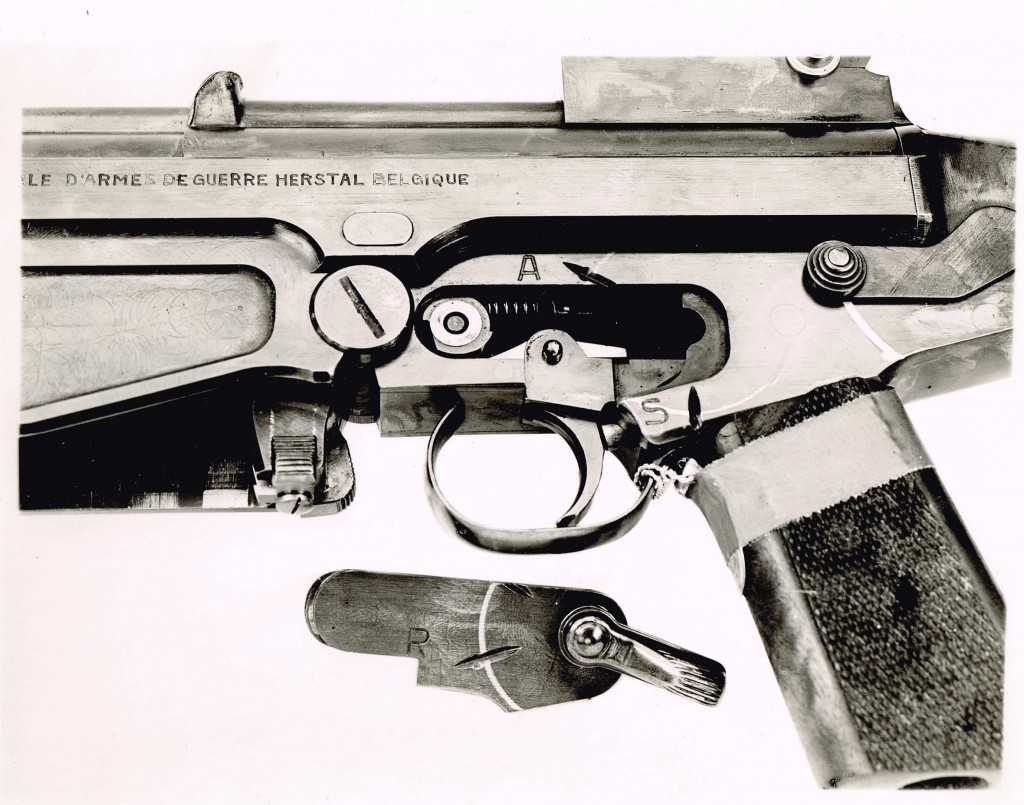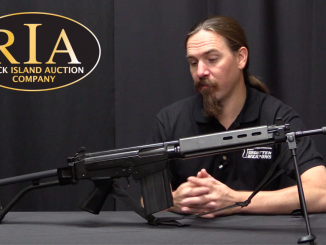As you may be aware, one of the very first prototype FAL designs was build for the German 8x33mm cartridge. The FAL was originally intended to be an intermediate-cartridge assault rifle along the same lines as the StG44, and it was only US stubbornness on keeping .30-06 ballistics that led to the FAL being scaled up to 7.62mm NATO.
Well, we found a couple archived photos of the 8mm Kurz prototype. We’d like to find more, but here are the two we have for the moment:

In this limited side view, we can see a bunch of design elements that would stay through to the final mass-production FAL rifles. The mag catch, bolt stop, and takedown lever are all basically unchanged. The detachable sideplate, of course, would be dropped. It is also worth noting that while the rifle was chambered for standard 8×33 ammunition, it used a proprietary FN mag and not the German StG magazine. The FAL receiver design isn’t wide enough to accommodate the German magazine.

The top view shows us some thing that would definitely not survive to mass production. Most notably, the charging handle was located up front on the gas tube, like later H&K rifles. The stripper clip guide would disappear later into development, and the muzzle brake design would change substantially. The rear sight is also interesting, with an aperture much like the final FAL but mounted on a WWII-style leaf for range adjustment (click on the photo to blow it up much larger). The rear sight starts at 50m and goes out to 500m in 50m increments – a much more realistic scale than the 1000m+ scales in widespread use on rifles at the time. FN actually understood the assault rifle concept, it would appear.
BTW, if you look closely at the top view, you can see that the rifle is marked serial number “1” just in front of the FN logo on the front of the receiver. Cool!
Interested in more of the FAL story? Here are some related posts you may not have seen:
Photos of the .280 British FAL
Photos of some other 1950s Light Rifle trials guns as well as the .280 FAL
Preliminary manual for the 8×33 and .280 FALs
Manual for the British X8E1 and X8E2 trials FALs
Modern FAL manual



Very cool! Thanks! I’m saving my dimes to become a premium member. Definitely worth some dosh. I do hope you’ve got some more pictures for us…
Q: Wasn’t there a faction in the French armed forces that considered adoption of the German 7.92x33mm kurz patrone? The .276 M1 Garand was a bit lighter and had a ten-round magazine. The 7x43mm/.280 really was “NATO’s lost chance” vis-a-vis the Kalashnikov. It is interesting that the U.S. perception of the MP44/StG44 and, later, the Kalashnikov was essentially thinking of them as a sort of beefed-up and revamped submachine gun concept…
The French indeed tested the 7.92×33 Kurz shortly after the war and did it extensively (together with the .30 carbine, it must be added), but their ultimate goal was to design something perfected after the Kurz patrone, not adopting it (though the interest shown by some high brass in the German cartridge is rumoured to have been more than just a passing thought). The Swiss also played with the concept (not just with the 7.92×33 but also with a few of their own design), but conservatives amid the military must have had the final word, given the longevity of the 7.5×55 well into the Cold War era.
I wonder how the magazine for 8mm FAL looked like. Was it curved as that of the StG-44 or rather straight like later FAL’s magazine for .280 or 7.62×51 cartridges? And what was the magazine’s capacity: 20 or 30 rounds?
Piotr
The magazine was straight just as those on the .280 or 7.62×51 FALs. I have no documentation but assume 20 rounds; it does not extend much below the lower end of the grip.
I didn’t know that!
I had two FALs in 7.62NATO and loved them.
I now have the STG43 and love it.
Didn’t know there was a relationship!!!
Thanks Ian.
For those 500m and 8×33 the barrel must have been somewhere close to 18″ long, at least. Any knowledge of that?
I would hardly consider 8mmkurz a ‘mighty’ shot.Reason for this was probably that it was readily available. Later developments at FH went on to longer casings. Something like 7.62×45 could be considered close to ideal.
Playing with the 300 AAC at the moment it’s amazing how similar that cartridge is in performance and shape to the 8 mm Kurz. Only took 70 years for that.
The FAL is one of two common “black rifles” that I like… though I am putting wood on mine as we speak. Saive was a genius.
The stripper clip guide may have disappeared in development, but it made a comeback in the Canadian C1 and C1A1 rifles, and C2 LMGs.
The difference in mag width is interesting, especially as the FAL appears to have been specifically designed around a .478″ diameter(Mauser) case head.
I need to read up on the forces in a staggered column mag, first thoughts are that the sideways vector of the forces is higher in a wider mag, so the wider mag needs a stronger mag spring to give the same feed reliability – but has the advantage of being shorter.
Single column mag – (ideally) no sideways vector – although there will be a slight one as the clearences mean that the cases won’t be absolutely vertical.
mag with the cases almost but just not quite side by side, they’re almost chocking each other with very little of the force of the mag spring going upwards.
Actually, if you have ideal 60deg stacking there is very little force pushing to side (I am talking about full 2 stacks all the way up). That is when left and right column are supported on their own weight plus spring force and side contact is just casual. The problem starts when width of the mag tube is narrower that the cos30 x base dia + 1base dia. In such case gets to serious jamming. Typically, for practical purposes such as mfg. tolerances, distortion during forming and so on some .010-.020″ is added. Also, the follower’s step height is of key importance. Finally, depending on cartridge taper and number of shots in mag the curvature. As you know, with 20rds both FAL and M14 did ok with straight mag. The Canadian C2 had 30rds in mag and it was still straight. That is nice thing about Win.308.
Hmmmm nothing wrong with insisting on 30 cal perhaps if they had just gone for the 300 Savage everyone would have been happy? A slightly smaller FAL sending a 150 or so grain at 2400-2500. If only life was so sensible.
.300 Savage would have been great! We would not be complaining about the 556 in Afghanistan, for one… but as for what-ifs, .276 Pedersen could still serve us well, and maybe better than any other round. If it were not for MacArthur, we might have it. .280 Enfield would also have been good.
On dual feed magazines, isn’t the side to side force minimized by the staggered followers that in I see in everything from Mausers to Masadas? Gun Digest back in ’93 or ’94 had an article about a .416 Mauser or some other absurdly large round in a Mauser and they had side force problems that I though were from an uneven push from the follower… it’s been a long time since I read that, so I could be misremembering.
As mentioned previously -no sideforce exists, unless the inner clearance is less than theoretical minimum. But, you can use mag tube with substantially smaller inside space than that and it will still feed ok. Then the contact will be more than ideal 60deg and you will have sideforce to cope with; this is used in some quickie conversions such as .300AAC in 5.56 mag. This ‘critical jam zone’ is quite narrow and easy to overcome. Not an ideal situation and hardly acceptable for military application though.
Hello, Denny :
With your knowledge and experience as an armorer, you could present ( as a guest writer ) some really informative technical articles on this site, with all proper respect to Ian and with his approval, that we could all learn from. You could even do it, if you prefer and depending on the subject, in partnership with other knowledgeable contributors such as Keith, Cyrus and Ruy Aballe. Just a thought, of course — FW and its subscribers have so much untapped individual and collective potential that is truly amazing.
Hi Earl
As revealed in previous instances I am indeed interested in military technology for decades. Having said that (and with consideration of what you said) it is the collective knowledge which really counts. I would gladly do or participate in a project of this sort, but for this it is important to have access to required materials to assist reader. I have very limited access, basically just like anyone else thru the Net. When I find something out, I bring it to Ian’s attention.
In the meantime, I enjoy to have exchange or to quip in with whatever I have on mind at the moment. It is fun!
As an owner of a modern-day FAL, I find this article on the rifle’s ancestry to be both fascinating and informative — many thanks, Ian.
I had not known abou the FAL in 8 mm x 33 calibre, but in my cartridge collection are 2 or 3 cartridges of this calibre with FN markings and postwar date. And fuune enought, one of them hat not a pointed FMJ bullet, but a more roundnose FMJ Bullet, similar to the 6,5 mm Carcano bullets.
With an FN FAL Rifle in 8 mm x 33 this cartridges make more sense.
This is really sad. I read this site by years and was a place to knowledge about historic weapons.
Now you must pay to read and see? Sorry, but its not fair to who can’t pay.
This site lost the respect from one loyal reader who disclosed the site to other friends.
Anderson.
The only part of the site that is limited to paying members is the discussion forum. The daily articles are, as always, freely available to everyone.
It’s a pity the morons in the Pentagon delayed the development of assault rifles in the West with their insistence of .30-06 level ballistics despite all the lessons of WW2 showing that such a high-powered round was not needed. And the brass then had the audacity to insist that their decision was based on the lessons of the war.